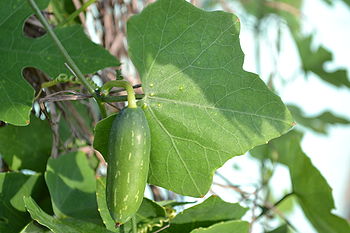Ivy Gourd
From Wikiwel
Other names : Calabacita, Calabaza Hiedra, Coccinia cordifolia, Coccinia grandis, Coccinia indica, Coccinia Índica, Courge Écarlate, Kovai, Little Gourd, Tela Kucha, Tindola, kundru, baby watermelon, gentleman’s toes.
Ivy gourd, or "Coccinia grandis", is a perennial vine with elongated red berries native to Asia and the Pacific Islands. The leaves and berries are edible, and all parts of the plant are used medicinally.
Special Precautions of Ivy Gourd
- This plant may enhance the effects of insulin so diabetics should consult a health care professional before taking ivy gourd.
- Surgery: Ivy gourd might lower blood sugar. There is some concern it might interfere with blood sugar control during and after surgery. Stop using ivy gourd at least 2 weeks before a scheduled surgery.
- Medications for diabetes (Antidiabetes drugs) interacts with Ivy Gourd
The benefits of Ivy Gourd are
- Historically, ivy gourd has been used to nourish the pancreas ... liver ... kidney ... and eyes.
- Practitioners of traditional and alternative healing modalities use ivy gourd as a remedy for conditions ranging from the common cough to anorexia.
- Local healers use it to treat cataracts, gonorrhea, psoriasis, cystitis, constipation and high cholesterol.
- The plant has a long history of use in Indian Ayurvedic medicine for treating diabetes, bronchitis and skin diseases. Active ingredients include triterpenoids, carotenoids, flavonoids, alkaloids and fatty acids, and the plant has antibacterial and hypoglycemic actions.
- diabetes : Blood sugar levels in new diabetics who consumed ivy gourd dropped by 16%. The botanical also reduced post-prandial blood glucose (sugar count after a meal) by 18%.Research suggests that ivy gourd supports healthy blood sugar by acting like natural insulin in your body.
- A study by G. Singh and colleagues published in the December 2007 issue of "Phytomedicine" tested a leaf extract for its action on blood lipids in animals. The study found that the extract significantly lowered triglycerides and total cholesterol, and the active constituent is a polyprenol. Polyprenols are terpenoids that have potent antioxidant and anti-cholesterol actions. This study supports the traditional use of ivy gourd for high cholesterol.
- the stem juice can be dripped into the eyes to treat cataracts.
- When applied topically, the leaves can be used as a soothing poultice for the treatment of skin irritations.
- When taken internally, the plant acts as a laxative and is sometimes used as an alternative treatment for gonorrhea.
